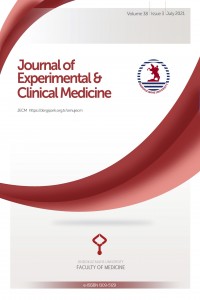Abstract
References
- Songur A. Tıp eğitimindeki çıkmazlardan biri: Fakülte yönetimi ile hastane yönetimi ikilemi. Tıp Eğitimi Dünyası (serial online) 2016 May-Aug: 46: (14 screens) Available from: https://dergipark.org.tr/tr/download/article-file/222446
- Crawshaw BP, Steele SR, Lee EC, Delaney CP, Mustain, WC, Russ, AJ, et al. Failing to Prepare Is Preparing to Fail: A Single-Blinded, Randomized Controlled Trial to Determine the Impact of a Preoperative Instructional Video on the Ability of Residents to Perform Laparoscopic Right Colectomy. Dis Colon Rectum 2016;59:32.
- Mavroudis C, Lees GP, Idriss R. Medical Illustration in the Era of Cardiac Surgery. World J for Pediatric Congenital Heart Surg 2020;11:209.
- Motsumi MJ, Bedada AG, Ayane G. The role of Moodle-based surgical skills illustrations using 3D animation in undergraduate training. Afr J of Health Prof Educ 2019;11:149.
- Farquharson AL, Cresswell AC, Beard JD, Chan P. Randomized trial of the effect of video feedback on the acquisition of surgical skills. British Journal of Surgery 2013; 100:1452.
- Kinder JS. Using instructional media. New York: Litton Educational Publishing Inc; 1973.
- Mota P, Nuno C, Carvalho-Dias E, Costa MJ, Correia-Pinto J, Lima E. Video-Based Surgical Learning: Improving Trainee Educationand Preparation for Surgery. J Surg Educ 2018;75:1.
- Pape-Koehler C., Immenroth M, Sauerland S, Lefering R, Lindlohr C, Toaspern J, et al. Multimedia-based training on Internet platforms improves surgical performance: a randomized controlled trial. Surg Endosc 2013;27:1746.
- Mavroudis C, Lees GP, Idriss R. Medical Illustration in the Era of Cardiac Surgery. World J Pediatr Congenit Heart Surg 2020;11:209.
- Akgül A, Kuş G, Mustafaoğlu R, Karaborklu AS. Is Video-Based Education an Effective Method in Surgical Education? A Systematic Review. J Surg Educ 2018;75:1.
The Opinions of Specialists and Students Regarding the Use of Visual and Written Expression Forms in Rhinoplasty Education
Abstract
Background: This research was conducted to investigate the contribution of visual and written expression to nasal surgery education and the preferences of usage. The research was conducted with the observation of cases in the Ear, Nose and Throat (ENT) Surgery Department of Ondokuz Mayıs University Medical Faculty. During the study, the processes of the ‘closed dorsum rhinoplasty’ cases were observed.
Methods: The case illustrations made as a result of the observations were presented to the study population comprising 36 medical students from 3 different universities (Ondokuz Mayıs University, Hitit University, İstanbul Medeniyet University). Data were obtained concerning the sampling of the research, the specialization areas of the participants, title groups, number of participants, and the information from the Likert type responses and the non-parametric statistical findings.
Results: The results showed that although the use of illustrations was seen to be more important according to the opinion of specialists and non-specialists in the area, sole use was concluded to be insufficient. A total of 43 of 60 ENT specialists and 9 of 11 Plastic Surgery specialists preferred the use of illustrations, photographs and written expression together. Non-specialists were seen to be undecided about their responses while no significant difference was found between specialists. The preferences of the participants were determined to be illustration, photography and written expression, respectively.
Conclusion: The results of this study indicate that the use of visual and written expression forms together when they are available is related to the quality of surgery education at a semantic level.
References
- Songur A. Tıp eğitimindeki çıkmazlardan biri: Fakülte yönetimi ile hastane yönetimi ikilemi. Tıp Eğitimi Dünyası (serial online) 2016 May-Aug: 46: (14 screens) Available from: https://dergipark.org.tr/tr/download/article-file/222446
- Crawshaw BP, Steele SR, Lee EC, Delaney CP, Mustain, WC, Russ, AJ, et al. Failing to Prepare Is Preparing to Fail: A Single-Blinded, Randomized Controlled Trial to Determine the Impact of a Preoperative Instructional Video on the Ability of Residents to Perform Laparoscopic Right Colectomy. Dis Colon Rectum 2016;59:32.
- Mavroudis C, Lees GP, Idriss R. Medical Illustration in the Era of Cardiac Surgery. World J for Pediatric Congenital Heart Surg 2020;11:209.
- Motsumi MJ, Bedada AG, Ayane G. The role of Moodle-based surgical skills illustrations using 3D animation in undergraduate training. Afr J of Health Prof Educ 2019;11:149.
- Farquharson AL, Cresswell AC, Beard JD, Chan P. Randomized trial of the effect of video feedback on the acquisition of surgical skills. British Journal of Surgery 2013; 100:1452.
- Kinder JS. Using instructional media. New York: Litton Educational Publishing Inc; 1973.
- Mota P, Nuno C, Carvalho-Dias E, Costa MJ, Correia-Pinto J, Lima E. Video-Based Surgical Learning: Improving Trainee Educationand Preparation for Surgery. J Surg Educ 2018;75:1.
- Pape-Koehler C., Immenroth M, Sauerland S, Lefering R, Lindlohr C, Toaspern J, et al. Multimedia-based training on Internet platforms improves surgical performance: a randomized controlled trial. Surg Endosc 2013;27:1746.
- Mavroudis C, Lees GP, Idriss R. Medical Illustration in the Era of Cardiac Surgery. World J Pediatr Congenit Heart Surg 2020;11:209.
- Akgül A, Kuş G, Mustafaoğlu R, Karaborklu AS. Is Video-Based Education an Effective Method in Surgical Education? A Systematic Review. J Surg Educ 2018;75:1.
Details
| Primary Language | English |
|---|---|
| Subjects | Health Care Administration |
| Journal Section | Clinical Research |
| Authors | |
| Publication Date | May 1, 2021 |
| Submission Date | April 5, 2021 |
| Acceptance Date | April 20, 2021 |
| Published in Issue | Year 2021 Volume: 38 Issue: 3 |
Cite

This work is licensed under a Creative Commons Attribution-NonCommercial 4.0 International License.


